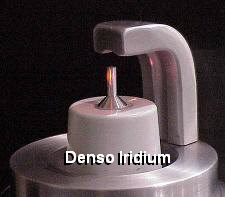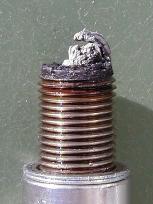ignition diagnosis Ignition & Spark Plugs Articles

Spark Plugs
Copyright AA1Car Adapted from an article written by Larry Carley for Underhood Service magazineThen came the Clean Air Act of 1970, followed by new emissions regulations and the introduction of catalytic converters in 1975. Leaded gasoline was gradually phased out because of its damaging effects on converters as well as the environment. As a result, spark plug life more than doubled.
In the mid-1980s, spark plug manufacturers started making plugs with copper core center electrodes. Copper is an excellent conductor of heat and allows plugs to run hotter without causing preignition. This improves fouling resistance, ignition reliability and plug life. It also reduces the number of plugs needed to cover a range of engine applications because each plug has a broader "heat range."
Platinum & Iridium Spark Plugs
Long-life spark plugs by ACDelco, Autolite, Bosch, Champion, Denso,NGK, and Split-Fire all have platinum or iridium electrodes. With a couple of exceptions, the platinum plugs use a conventional electrode configuration with a small platinum plug welded to the tip of one or both electrodes. ACDelco also offers a platinum version of its "Rapidfire" plug that features a fluted center electrode for improved ignition reliability. Likewise, Split-Fire offers a platinum version of its split electrode plugs for motorists who want extended life as well as reduced misfiring. By comparison, iridium plugs have a small wire center electrode.
Bosch, who introduced the first platinum plug back in 1985, offers several different electrode configurations in their product line. Their standard platinum plug has a thin pure platinum center electrode with a single yttrium-alloy end electrode. Their Platinum+2 and Platinum+4 plugs, on the other hand, have a unique "surface gap" side electrode design with two side electrodes on the Platinum+2 plug and four on the Platinum+4 - a sort of good, better, best approach to platinum plug technology. Increasing the number of side electrodes gives the spark more paths to ground and reduces the risk of misfire, while extending plug life by spreading wear over more electrode surfaces.

Although platinum spark plugs have many performance advantages over conventional spark plugs, iridium spark plugs offer even more advantages. The most important advantage is the longest service life of any spark plug (up to 4X longer than a standard spark plug, or 120,000 miles for many applications. Iridium last so long because the metal alloy is even more wear resistant than platinum. Iridium is usually alloyed with rhodium, creating a center electrode that is six times harder and eight times stronger than platinum. It is also one of the densest metals known.
The use of iridium spark plugs as original equipment in late model vehicles has grown considerably in recent years due to its performance and cost advantages. Iridium plugs are often used in engines with Gasoline Direct Injection for improved ignition reliability. Iridium spark plugs have also become a good upgrade option for replacing standard spark plugs or platinum spark plugs in older engines, too.
Spark Plug Electrode Magic
Spark plug manufacturers tout the advantages of their unique electrode designs, but regardless of the design, the purpose is to make it as easy as possible for the plug to fire reliably. A spark jumps more easily from a sharp edge than a rounded blunt edge. So the more sharp edges it has to jump to, the better the odds of the plug firing under all types of driving conditions. The electrodes on some spark plugs are also designed to "unshroud" the spark so more of the spark will be exposed to the air/fuel mixture. This improves the propagation of the flame kernel once the fire is lit.Ruthenium Spark Plugs
The latest development in spark plug technology is Ruthenium Spark Plugs. Electrodes made of a special ruthenium alloy are said to last 2X longer than current iridium spark plugs, and 4X longer than standard nickel electrode spark plugs. The increased wear resistance of the electrodes means these plugs may truly become "lifetime" spark plugs that never need to be replaced. They are also said to offer better ignitability for improved performance, emissions, fuel economy and acceleeration.
 NGK RUTHENIUM HX Spark Plugs
NGK RUTHENIUM HX Spark PlugsSpark Plugs Getting Smaller
Another trend in the ongoing evolution of spark plugs is that plugs are shrinking. The Ford Triton engines use long-reach 10 mm plugs from Autolite, which are 4 mm skinnier than the 14 mm plugs you're used to seeing in most late-model engines. The threads on these plugs are also 1-3/8" above the end of the plug, so heat has a long ways to travel before it can be dissipated through the threads into the cylinder head. This requires a couple of tricks to manage heat. One is an unusual "U" shaped end electrode that wraps all the way over the end of the plug. Connecting both ends of the electrode to the plug shell creates two paths for heat to flow away from the tip. The end electrode is made of a special high temperature Inconel alloy. In the center of the "U" is a small platinum pad to reduce electrode wear when the plug fires. The center electrode is also platinum tipped and has a copper core to help pull heat away from the tip.Spark Plug Fouling Resistance

One thing all types of spark plugs must do is resist fouling. The trick here is to keep the electrodes hot enough to burn off fouling deposits but not so hot that they cause preignition. To burn off carbon deposits, the center electrode needs to reach about 700 degrees F quickly. But if it gets too hot (above -1,500 degrees F depending on the plug design), it may ignite the fuel before the spark occurs, causing preignition and detonation. For most plugs, the ideal operating temperature is around 1,200 degrees F.
Spark Plug Misfires
The voltage required to produce a spark can range from as little as 5,000 volts to as much as 30,000 volts or higher. The actual firing voltage will vary depending on operating conditions such as engine load, rpm, temperature, compression and the richness or leanness of the air/fuel mixture. The wider the electrode gap and the greater the load on the engine, the more voltage it takes to fire the spark plugs. Likewise, the higher the resistance in the spark plugs and plug wires, the higher the required firing voltage.Reading Spark Plugs
 Click on image to view Spark Plug Diagnosis Chart.
Click on image to view Spark Plug Diagnosis Chart.Reading the condition of the old spark plugs can reveal a lot about other problems that may be going on inside the engine, things like lean fuel mixture, rich fuel mixture, oil burning, overheating, overadvanced ignition timing, detonation/preignition and more. Replacing the spark plugs will not solve any of these problems, and the new spark plugs will likely suffer the same kind of fouling, wear or damage unless the underlying problem is diagnosed and repaired.
Replacing Spark Plugs
As a rule, replacement spark plugs should have the same or better service interval as the original plugs. The brand does not matter, though many vehicle owners and technicians prefer to use the same brand of spark plug as the original when they replace plugs.
Choosing Racing Spark Plugs
Selecting the proper spark plugs for a performance engine can mean the difference between front of the pack and not finishing the race. When using this guide, understand that race plugs are usually of a much colder heat range rating than standard automotive spark plugs. Colder spark plugs must be used in engines with increased cylinder pressures, higher temperatures and greater horsepower. Other factors such as fuel delivery (turbo, supercharged), fuel types and piston-to-head clearance will also affect proper plug selection. Step 1: Shell Design - The first step in choosing the proper race spark plug is determining the plug type that your cylinder head/piston will accept. Thread diameter and pitch, thread length and shell seat, as well as hex size are all factors that will define what shell type works best for your engine. Step 2: Electrode Design - The second decision is electrode design and configuration. Is it a fine wire center or standard electrode? Projected or non-projected? Full coverage 'J-Gap' or perhaps a cut-back or angled ground wire? A good rule of thumb is to attain as much projection into the cylinder as possible. But be aware of piston clearance that could prohibit projected spark plugs from being used. Step 3: Heat Range - The third factor in choosing a race plug is heat range. Correct heat range is critical in maintaining peak performance throughout the duration of your race or event. Switching to a colder or hotter plug will not increase horsepower, but could affect engine performance. Choosing a plug that is too hot can result in preignition or detonation. A plug that is too cold could cause an engine to stumble, misfire or foul. The main factors to consider in selecting the proper heat range are: type of race, methanol, specific output, nitro-meth, compression ratio, nitrous oxide, horsepower, super or turbo charging and racing fuel. Courtesy: Champion Spark Plugs |
Spark Plug Replacement Tips
Courtesy NGK Spark Plugs (USA), Inc. |
Spark Plug Torque and Gap
 Spark plugs come pregapped from the factory, but because of parts consolidation the factory gap may not always the specified gap for your engine. Always refer to the specified electrode gap on your engine emissions decal. This typically ranges from .028 to .034 inches. Wider gaps are often required for leaner air/fuel mixtures, but if the gap is too wide it increases the risk of misfire when the engine is under load. On Bosch Platinum+4 and Platinum2 spark plugs, DO NOT change the factory electrode gap regardless of what the gap specification is for your engine. The Bosch plugs come with a 1.6-mm gap, which Bosch says works for ALL applications with their unique spark plug design. How much the spark plugs should be tightened depends on the size of the plugs and the type of plug seat. Spark plugs with gasket-style seats require more torque than those with taper seats. Always follow vehicle manufacturer torque recommendations, but as a general rule:
Courtesy Robert Bosch Corp. |
Ignition Related Articles:
Ruthenium Spark PlugsDon't Neglect the Spark Plugs
Why Spark Plugs Still Need To Be Replaced
Spark Plug Fouling
Don't Use Ordinary Spark Plugs with Waste Spark DIS Ignition Systems
Bosch Platinum +4 Spark Plugs
Original Equipment Spark Plugs, Are They Best?
Ford Motorcraft Spark Plug Breakage Problem (2004 - 2008 Ford Trucks w/5.4L V8, & 2005 - 2008 Mustang GT with 4.6L V8)
Spark Plug Wires
Ignition Misfires
Spark Plugs & Ignition Performance
Chevy Firing Orders
Chrysler Firing Orders
Ford Firing Orders
Distributor Ignition Systems
Distributorless Ignition Systems
Coil-Over-Plug Ignition Systems
Multi-Coil Ignition Systems
Diagnosing An Engine that Won't Crank or Start
Troubleshooting Intermittent Engine Problems
Spark Knock (Detonation)



 Traduction
Traduction

Leave a Comment